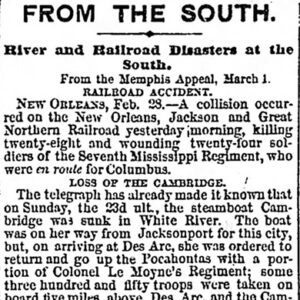calsfoundation@cals.org
Cambridge [Steamboat]
The steamboat Cambridge was carrying a regiment of Confederate soldiers on the White River when it struck a snag and sank near Grand Glaise (Jackson County) on February 23, 1862.
The Cambridge was a 242-ton sternwheel paddleboat built in 1856 for Captain William Dean, who ran it on a route going from Pittsburgh, Pennsylvania, to Cincinnati, Ohio, to St. Louis, Missouri. Around January 1862, Captain John Williams bought the Cambridge for $7,000, operating out of Memphis, Tennessee.
The Cambridge became a troop transport by coincidence. Colonel G. W. LeMoyne had assembled his Seventeenth Arkansas Infantry Regiment (CS) in Little Rock (Pulaski County) and was preparing to go to Pocahontas (Randolph County) when a measles outbreak struck the Confederate troops. LeMoyne sent his sick soldiers toward Pocahontas on the steamboat S. H. Tucker, then marched north with the rest of his men.
Bad weather and illness continued to plague the Confederates, so LeMoyne turned to the White River to commandeer a steamboat to carry his men to Pocahontas. He stopped the Cambridge, which was headed back to Memphis from Jacksonport (Jackson County), about six miles from Des Arc (Prairie County) on February 22, and loaded his troops—contemporary reports vary their number between 260 and 350—aboard.
The next day, as the Cambridge passed Dudley’s Bend on the White River, a strong wind buffeted the steamboat, and it hit a log, which punctured its hull; the Cambridge sank in four minutes, leaving only its hurricane deck above the water. “The consternation on board was of course very great, and many persons jumped into the water,” a newspaper reported. “Coolness and presence of mind was shown by others, who aided in rescuing from the water some of those who were drowning, and in aiding others to get on the hurricane deck.”
The S. H. Tucker came across the wreckage and transported the survivors to Pocahontas. They would transfer east of the Mississippi River, where the six companies of LeMoyne’s understrength Seventeenth Arkansas Infantry were consolidated with four companies of McCarver’s Fourteenth Arkansas Infantry Regiment (CS) to form the Twenty-first Arkansas Infantry (CS) on May 15, 1862, at Corinth, Mississippi.
Contemporary sources place the Cambridge death toll at from thirty-seven to forty-seven soldiers and passengers—including a man and his three children—along with five deck hands.
The Cambridge sinking provides another illustration of the dangers of steamboat travel in Arkansas waters in the nineteenth century, when encounters with snags also caused mass casualties on the Belle Zane in 1845, the John Adams in 1851, the B. M. Runyan in 1864, the Mercury in 1867, the G. A. Thompson in 1869, and the Nick Wall in 1870.
For additional information:
“From the South.” Detroit Free Press, March 11, 1862, p. 3.
Huddleston, Duane, Sammie Cantrell Rose, and Pat Taylor Wood. Steamboats and Ferries on the White River: A Heritage Revisited. Fayetteville: University of Arkansas Press, 1998.
“The Sinking of the CSS Cambridge,” Stream of History 26 (Fall 1989): 10–11.
“The Steamer ‘Cambridge.’” Washington Telegraph, March 12, 1862, p. 2.
Way, Frederick, Jr. Way’s Packet Directory. Athens: Ohio University Press, 1983.
Mark K. Christ
Central Arkansas Library System
 Civil War through Reconstruction, 1861 through 1874
Civil War through Reconstruction, 1861 through 1874 Transportation
Transportation Cambridge Steamboat Article
Cambridge Steamboat Article 




Comments
No comments on this entry yet.